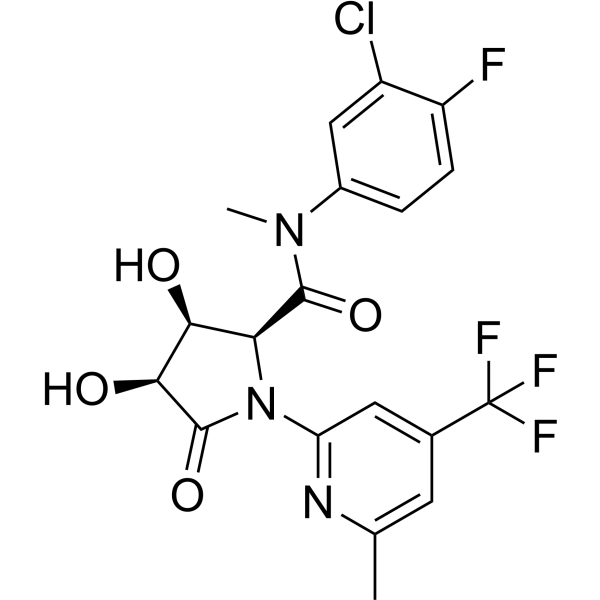Physicochemical Properties
| Molecular Formula | C19H16CLF4N3O4 |
| Molecular Weight | 461.79 |
| Exact Mass | 461.08 |
| Elemental Analysis | C, 49.42; H, 3.49; Cl, 7.68; F, 16.46; N, 9.10; O, 13.86 |
| CAS # | 2607138-82-7 |
| PubChem CID | 156077039 |
| Appearance | White to yellow solid powder |
| LogP | 2.8 |
| Hydrogen Bond Donor Count | 2 |
| Hydrogen Bond Acceptor Count | 9 |
| Rotatable Bond Count | 3 |
| Heavy Atom Count | 31 |
| Complexity | 700 |
| Defined Atom Stereocenter Count | 3 |
| SMILES | N1(C2=NC(C)=CC(C(F)(F)F)=C2)C(=O)[C@@H](O)[C@@H](O)[C@H]1C(N(C1=CC=C(F)C(Cl)=C1)C)=O |
| InChi Key | YJJOABOMFPGRED-JYJNAYRXSA-N |
| InChi Code | InChI=1S/C19H16ClF4N3O4/c1-8-5-9(19(22,23)24)6-13(25-8)27-14(15(28)16(29)18(27)31)17(30)26(2)10-3-4-12(21)11(20)7-10/h3-7,14-16,28-29H,1-2H3/t14-,15-,16-/m0/s1 |
| Chemical Name | (2S,3S,4S)-N-(3-chloro-4-fluorophenyl)-3,4-dihydroxy-N-methyl-1-[6-methyl-4-(trifluoromethyl)pyridin-2-yl]-5-oxopyrrolidine-2-carboxamide |
| Synonyms | ART812 |
| HS Tariff Code | 2934.99.9001 |
| Storage |
Powder-20°C 3 years 4°C 2 years In solvent -80°C 6 months -20°C 1 month |
| Shipping Condition | Room temperature (This product is stable at ambient temperature for a few days during ordinary shipping and time spent in Customs) |
Biological Activity
| Targets | Polθ ( IC50 = 7.6 nM ) |
| ln Vitro | In MDA-MB-436 SHLD2 mutant cells, ART812 (0–40 μM) promotes Polθ inhibitor sensitivity [1] |
| ln Vivo | In rats exhibiting MDA-MB-436 BRCA1/SHLD2-deficient tumors (volume 250-350 mm3), ART812 (100 mg/kg; administered orally daily for 76 days) showed notable tumor reduction [1] |
| References |
[1]. Polθ inhibitors elicit BRCA-gene synthetic lethality and target PARP inhibitor resistance. Nat Commun. 2021 Jun 17;12(1):3636. [2]. Preparation of heterocyclic compounds for use in the treatment of cancer. WO2021028643 A1. |
Solubility Data
| Solubility (In Vitro) | DMSO : ~100 mg/mL (~216.6 mM) |
| Solubility (In Vivo) |
Solubility in Formulation 1: ≥ 2.5 mg/mL (5.41 mM) (saturation unknown) in 10% DMSO + 40% PEG300 + 5% Tween80 + 45% Saline (add these co-solvents sequentially from left to right, and one by one), clear solution. For example, if 1 mL of working solution is to be prepared, you can add 100 μL of 25.0 mg/mL clear DMSO stock solution to 400 μL PEG300 and mix evenly; then add 50 μL Tween-80 to the above solution and mix evenly; then add 450 μL normal saline to adjust the volume to 1 mL. Preparation of saline: Dissolve 0.9 g of sodium chloride in 100 mL ddH₂ O to obtain a clear solution. Solubility in Formulation 2: ≥ 2.5 mg/mL (5.41 mM) (saturation unknown) in 10% DMSO + 90% (20% SBE-β-CD in Saline) (add these co-solvents sequentially from left to right, and one by one), suspension solution. For example, if 1 mL of working solution is to be prepared, you can add 100 μL of 25.0 mg/mL clear DMSO stock solution to 900 μL of 20% SBE-β-CD physiological saline solution and mix evenly. Preparation of 20% SBE-β-CD in Saline (4°C,1 week): Dissolve 2 g SBE-β-CD in 10 mL saline to obtain a clear solution. Solubility in Formulation 3: ≥ 2.5 mg/mL (5.41 mM) (saturation unknown) in 10% DMSO + 90% Corn Oil (add these co-solvents sequentially from left to right, and one by one), clear solution. For example, if 1 mL of working solution is to be prepared, you can add 100 μL of 25.0 mg/mL clear DMSO stock solution to 900 μL of corn oil and mix evenly. (Please use freshly prepared in vivo formulations for optimal results.) |
| Preparing Stock Solutions | 1 mg | 5 mg | 10 mg | |
| 1 mM | 2.1655 mL | 10.8274 mL | 21.6549 mL | |
| 5 mM | 0.4331 mL | 2.1655 mL | 4.3310 mL | |
| 10 mM | 0.2165 mL | 1.0827 mL | 2.1655 mL |
